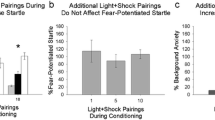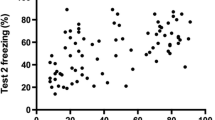Abstract
The fear-potentiated startle response paradigm is used to investigate anxiolytic properties of drugs. The first objective of the present study was to further investigate the predictive validity of this paradigm. The anxiolytics chlordiazepoxide (2.5–10 mg/kg IP) and oxazepam (1–10 mg/kg PO) and the putative anxiolytic flesinoxan (1–10 mg/kg PO) decreased startle potentiation dose-dependently, indicating an anxiolytic effect. The antidepressant fluvoxamine (5–20 mg/kg PO) did not affect startle potentiation. Ideally, anxiolytic drugs attenuate startle potentiation without affecting control startle levels, although some studies report altered control startle amplitudes. The second objective was to investigate whether different effects on control startle amplitudes are related to different startle devices. Therefore, the drugs were tested in two laboratories. Results showed no significant differences between laboratories, indicating that equipment is not a critical factor in the drug-induced alteration of control startle levels. In an additional experiment, it was shown that flesinoxan (10 mg/kg PO) did not affect strychnine-induced startle potentiation, supporting the idea that the attenuating effect of flesinoxan on the fear-potentiated startle response is due to its anxiolytic properties. Thus, the fear-potentiated startle response paradigm appears a valid and reliable model for anxiolytic properties of drugs.
Similar content being viewed by others
References
Berg WK, Davis M (1984) Diazepam blocks fear-enhanced startle elicited electrically from the brainstem. Physiol Behav 32:33–336
Bill DJ, Fletcher A, Glenn BD, Knight M (1992) Behavioural studies on WAY100289, a novel 5-HT3 receptor antagonist, in two animal models of anxiety. Eur J Pharmacol 218:327–334
Borszcz GS, Cranney J, Leaton RN (1989) Influence of long-term sensitization on long-term habituation of the acoustic startle response in rats: central grey lesions, preexposure, and extinction. J Exp Psychol [Anim Behav Proc] 15:54–64
Davis M (1979a) Diazepam and flurazepam: effects on conditioned fear as measured with the potentiated startle paradigm. Psychopharmacology 62:1–7
Davis M (1979b) Morphine and naloxone: effects on conditioned fear as measured with the potentiated startle paradigm. Eur J Pharmacol 54:341–347
Davis M (1988) Apomorphine,d-amphetamine, strychnine and yohimbine do not alter prepulse inhibition of the acoustic startle reflex. Psychopharmacology 95:151–156
Davis M, Cassella JV, Kehne JH (1988) Serotonin does not mediate anxiolytic effects of buspirone in the fear-potentiated startle paradigm: comparison with 8-OH-DPAT and ipsapirone. Psychopharmacology 94:14–20
Davis M, Redmond DE Jr, Baraban JM (1979) Noradrenergic agonists and antagonists: effects on conditioned fear as measured by the potentiated startle paradigm. Psychopharmacology 65:111–118
Davis M, Falls WA, Campeau S, Kim M (1993) Fear-potentiated startle: a neural and pharmacological analysis. Behav Brain Res 58:175–198
Frankland PW, Yeomans JS (1995) Fear-potentiated startle and electrically evoked startle mediated by synapses in rostrolateral midbrain. Behav Neurosci 109:669–680
Groenink L, Van der Gugten J, Verdouw PM, Maes RAA, Olivier B (1995) The anxiolytic effects of flesinoxan, a 5-HT1A receptor agonist, are not related to its neuroendocrine effects. Eur J Pharmacol 280:185–193
Hijzen TH, Slangen JL (1989) Effects of midazolam, DMCM and lindane on potentiated startle in the rat. Psychopharmacology 99:362–365
Hijzen TH, Houtzager SWJ, Joordens RJE, Olivier B, Slangen JL (1995) Predictive validity of the potentiated startle response as a behavioral model for anxiolytic drugs. Psychopharmacology 118:150–154
Kehne JH, Cassella JV, Davis M (1988) Anxiolytic effects of buspirone and gepirone in the fear-potentiated startle paradigm. Psychopharmacology 94:8–13
Kehne JH, McCloskey TC, Taylor VL, Black CK, Fadayel GM, Schmidt CJ (1992) Effects of the serotonin releasers 3,4-methylenedioxymethamphetamine (MDMA), 4-chloroamphetamine (PCA) and fenfluramine on acoustic and tactile startle reflexes in rats. J Pharmacol Exp Ther 260:78–89
Mansbach RS, Geyer MA (1988) Blockade of potentiated startle responding in rats by 5-hydroxytryptamine1A receptor ligands. Eur J Pharmacol 156:375–383
Mansbach RS, Geyer MA, Braff DL (1988) Dopaminergic stimulation disrupts sensorimotor gating in the rat. Psychopharmacology 94:507–514
Molewijk HE, Van der Poel AM, Mos J, Van Heyden JAM, Olivier B (1995) Conditioned ultrasonic distress vocalizations in adult male rats as a behavioural paradigm for screening anti-panic drugs. Psychopharmacology 117:32–40
Mos J, Olivier B (1989) Ultrasonic vocalizations by rat pups as an animal model for anxiolytic activity: effects of serotonergic drugs. In: Bevan P, Cools AR, Archer T (eds) Behavioural pharmacology of 5-HT. Lawrence Erlbaum Associates, New Jersey, pp 361–369
Nevins ME, Anthony EW (1994) Antagonists at the serotonin-3 receptor can reduce the fear-potentiated startle response in the rat: evidence for different types of anxiolytic activity? J Pharmacol Exp Ther 268:248–254
Olivier B, Bosch L, Van Hest A, Van der Heyden J, Mos J, Van der Poel G, Schipper J, Tulp M (1993) Preclinical evidence on the psychotropic profile of fluvoxamine. Pharmacopsychiatry 26:2–9
Swerdlow NR, Britton KT (1994) Alphaxalone, a steroid anesthetic, inhibits the startle-enhancing effects of corticotropin releasing factor, but not strychnine. Psychopharmacology 115:141–146
Author information
Authors and Affiliations
Rights and permissions
About this article
Cite this article
Joordens, R.J.E., Hijzen, T.H., Olivier, B. et al. Fear-potentiated startle response is remarkably similar in two laboratories. Psychopharmacology 126, 104–109 (1996). https://doi.org/10.1007/BF02246344
Received:
Revised:
Issue Date:
DOI: https://doi.org/10.1007/BF02246344




